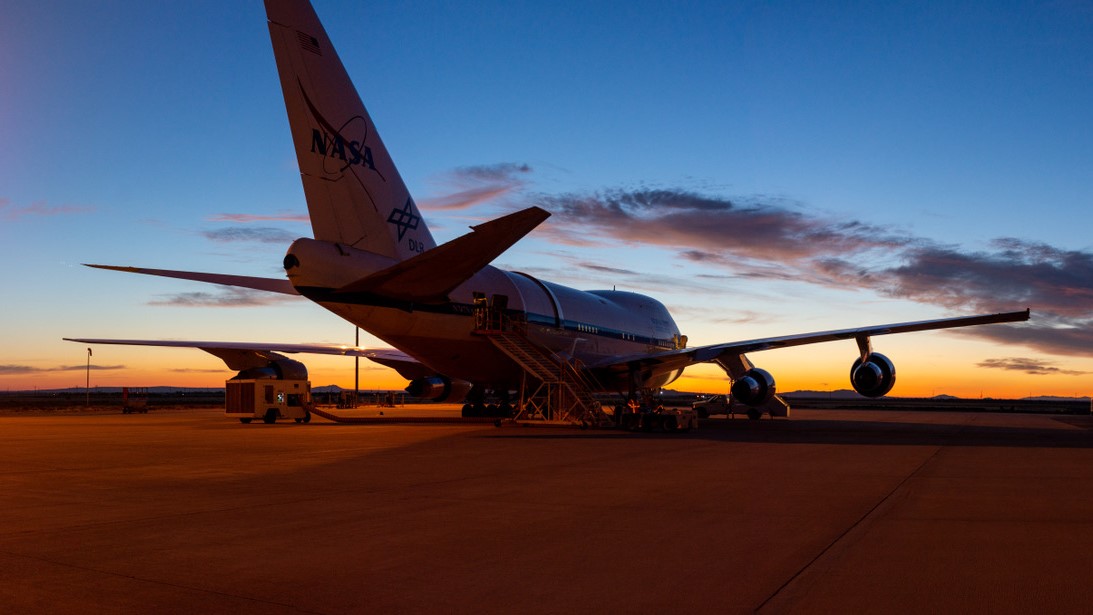NASA's Airborne Observatory SOFIA Takes Flight Over Europe Today
It will observe two black holes at the center of a distant galaxy.

Today (Sept. 18) a unique airborne space observatory will perform its first scientific flight over Europe. Its mission will be to study activity around a pair of co-orbiting black holes about 600 million light-years away from Earth.
SOFIA, or Stratospheric Observatory for Infrared Astronomy, is a modified Boeing 747 jumbo jet that ascends to our stratosphere — between 38,000 to 45,000 feet (11,582 to 13,716 meters) high — so that the 2.7-meter (106 inches) reflecting telescope on board can be above 99% of the part of Earth's atmosphere that absorbs infrared light coming from the cosmos.
This joint project of the German Aerospace Center (DLR) and NASA allows astronomers to study the universe with greater clarity. And by observing in infrared light, scientists can look at the heat energy emitted from objects in the universe and study distant structures that would otherwise be obscured by clouds of dust.
Related: Photos from SOFIA, NASA's Flying Telescope
SOFIA will perform a 10-hour flight over Europe between today and tomorrow (Sept. 19), according to a statement from DLR. The airborne observatory was expected to arrive at Stuttgart Airport in Germany on Sunday (Sept. 15), where a large welcoming reception awaited the scientific plane, according to officials from the University of Stuttgart. But there was a technical problem involving the wing and poor weather conditions at the aircraft's home base in Palmdale, California, where it was going to take off, so SOFIA's flight was delayed by 24 hours.
From Sept. 18th - 19th , SOFIA will conduct her first scientific flight over Europe, investigating e.g. the influence of magnetic fields around the black hole of the active galaxy Markarian 231. https://t.co/8rgNjO1cE7@Uni_stuttgart @SOFIAtelescope @STR_Airport #SOFIAgermany pic.twitter.com/1mj5c2YoxASeptember 5, 2019
SOFIA finally made it to Stuttgart the next day, according to a tweet published in the early hours of Sept. 16 by the observatory's Twitter account.
When it takes off, SOFIA will be studying several objects in the universe, and its key focus will be on Markarian 231, a galaxy located about 600 million light-years away. That's about 300 times farther away than Andromeda, the Milky Way's closest neighboring galaxy — and so far away that the light we see coming from the galaxy today began traveling this way before our planet developed multicelled life.
Breaking space news, the latest updates on rocket launches, skywatching events and more!
According to DLR, this distant galaxy is one of the brightest and best-known ultraluminous infrared galaxies. At its center, it hosts two black holes of different sizes. This active galactic nucleus is interesting to scientists wanting to learn if the jets of material spewing from the centers of certain galaxies are caused by the presence or absence of magnetic fields. This research will be accompanied by other projects looking at stellar births and deaths.
DLR also reported that a team from the popular German children's television show "Broadcast with the Mouse" ("Sendung mit der Maus") will fly along with the scientists on today's flight, and an upcoming episode will feature SOFIA in a special segment about telescopes and infrared astronomy.
- Now You Can 3D-Print a NASA SOFIA Flying Telescope of Your Very Own!
- Nichelle Nichols, Uhura on 'Star Trek,' Boldly Rides NASA's Flying Observatory
- NASA to Adjust SOFIA Flying Telescope's Operations to Improve Productivity
Follow Doris Elin Urrutia on Twitter @salazar_elin. Follow us on Twitter @Spacedotcom and on Facebook.

Doris is a science journalist and Space.com contributor. She received a B.A. in Sociology and Communications at Fordham University in New York City. Her first work was published in collaboration with London Mining Network, where her love of science writing was born. Her passion for astronomy started as a kid when she helped her sister build a model solar system in the Bronx. She got her first shot at astronomy writing as a Space.com editorial intern and continues to write about all things cosmic for the website. Doris has also written about microscopic plant life for Scientific American’s website and about whale calls for their print magazine. She has also written about ancient humans for Inverse, with stories ranging from how to recreate Pompeii’s cuisine to how to map the Polynesian expansion through genomics. She currently shares her home with two rabbits. Follow her on twitter at @salazar_elin.
